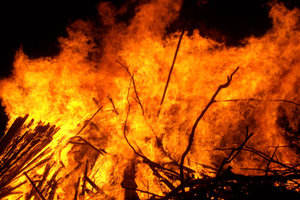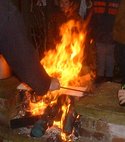Fire
|
|
- For other uses, see Fire (disambiguation).
 A large bonfire
A large bonfire
Fire is a form of combustion. Most typically, the word fire refers to the combination of the brilliant glow and large amount of heat released during a rapid, self-sustaining exothermic oxidation process of combustible gases ejected from a fuel. The flames are a body of gas that releases heat and light. Fires start when a fuel is subjected to heat or another energy source, e.g. a match or lighter, and are sustained by the further release of heat energy until all the combustible fuel is consumed.
The word fire by itself often designates uncontrolled fires rather than referring to controlled fires.
| Contents |
Controlling fire
Controlling fire for the purposes of providing heat and light was one of humankind's first great achievements. It made possible migration to colder climates which otherwise would have remained out of reach for colonization. It also allowed for cooking food and using flame and heat to process materials. Archaeology indicates that ancestors of modern humans such as Homo erectus seem to have been using controlled fire as early as some 790,000 years ago. The Cradle of Humankind site has evidence for controlled fire 1 million years ago.
Fire and religion
Fires and burning have often been used in religious rites and symbolism, as the smoke of the fire disperses into the heavens. Fire is one of the four classical elements, as well as one of the five Chinese elements. In Hinduism fire is one of five sacred elements of which all living creatures are comprised and is considered an eternal witness essential to sacred religious ceremonies. In Christianity, fire is a symbol of the Holy Spirit and is often used in descriptions of Hell. Fire is constantly used by the Zoroastrian religion in order to represent the Ahura Mazda, or God, of the Zoroastrians, including the fire at Yazda, which has been burning for over two millenia. Fire is also an important part of Calcinatio, the fire operation in the art of alchemy.
Material used to start fires
The burning of wood is often the first association to the word fire, and trees have since ancient times supplied much of the energy needed by humans. In the past, metal smelting and charcoal production consumed large quantities of wood for their production. Nowadays, large scale energy is usually not produced by fires of burning wood, but has been replaced by hydrocarbon oil and coal, and in some cases nuclear energy or renewable energy sources. Wood burning remains a heat source in many Third world countries and where other sources of energy are unavailable, often leading to deforestation. Accelerants can be used to spread fire faster or have it burn hotter.
Uncontrolled fire
Wohnhausbrand.JPG
Uncontrolled, fire can be extremely hazardous both to living things and to structures. Exposure to uncontrolled fire can result in severe burns and the symptoms of smoke inhalation. Fire in a building can be started by cooking accidents, electrical faults, fuel leaks, children playing with lighters and/or matches, and accidents involving other fire sources such as candles and cigarettes. Fire can propagate rapidly to other structures, especially where proper building standards are not met. For this reason, most municipalities offer fire fighting services to quickly extinguish fire and deal with other problems. Forest fires, though sometimes necessary for the renewal of forests, can cause severe property damage over a wide area.
In Europe and Australasia 6 groups are used:
- Class A: Fires that involve flammable solids such as wood, cloth, rubber, paper, and some types of plastics.
- Class B: Fires that involve flammable liquids or liquifiable solids such as petrol/gasoline, oil, paint,some waxes & plastics, but NOT cooking fats or oils.
- Class C: Fires that involve flammable gases, such as natural gas, hydrogen, propane, butane
- Class D: Fires that involve combustible metals, such as sodium, magnesium, and potassium.
- Shock Risk (formerly known as Class E): Fires that involve any of the materials found in Class A and B fires, but with the introduction of an electrical appliances, wiring, or other electrically energized objects in the vicinity of the fire, with a resultant electrical shock risk if a conductive agent is used.
- Class F: Fires involving cooking fats and oils. The high temperature of the oils when on fire far exceeds that of other flammable liquids making normal extinguishing agents ineffective
Forestfire2.jpg
In the U.S., fires are generally classifed into four groups: A, B, C, and D.
- Class A: Fires that involve wood, cloth, rubber, paper, and some types of plastics.
- Class B: Fires that involve gasoline, oil, paint, natural and propane gases, and flammable liquids, gases, and greases.
- Class C: Fires that involve any of the materials found in Class A and B fires, but with the introduction of an electrical appliances, wiring, or other electrically energized objects in the vicinity of the fire.
- Class D: Fires that involve combustible metals, such as sodium, magnesium, and potassium.
A fifth group, Class K, is sometimes added. It refers to fires involving large amounts of grease or oil. Although, by definition, Class K is a subclass of Class B, the special characteristics of these types of fires are considered important enough to recognize.
Blacksmiths_fire.jpg
Science of fire
A flame is a self-sustaining oxidizing chemical reaction producing energy and ionized gas (plasma). It consists of reacting gases emitting visible and infrared light, the frequency spectrum of which is dependant on the chemical composition of the burning elements and intermediate reaction products. In many cases such as burning organic matter like wood or incomplete combustion of gas, incandescent solid particles (soot) produce the familiar red-orange 'fire' color light. This light has a continuous spectrum. Complete combustion of gas has a dim blue color due to the emission of single wavelength radiations from various electron transitions in the excited molecules formed in the flame. Usually oxygen is involved, but hydrogen burning in chlorine produces a flame as well, producing hydrogen chloride (HCl). This gas dissolved in water is called hydrochloric acid. Other possible combinations producing flames (amongst many more) are fluorine and hydrogen or hydrazine and nitrogen tetroxide.
The glow of a flame is somewhat complex, due to a mix of black-body radiation emitted from soot, gas, and fuel particles (though the soot particles are too small to behave like perfect blackbodies), and from photon emission by de-excited atoms and molecules in the gases. Much of the radiation is emitted in the visible and infrared bands. The color depends on temperature for the black-body radiation, and chemical makeup for the emission spectra.
Lightmatter_carbq.jpg
See also
- Arson
- Backdraft
- Bonfire
- Bushfire
- Campfire
- Explosion- One of the other forms of combustion/oxidation
- Fire drill
- Fire eater
- Fire hydrant
- Fire point
- Fire-retardant material
- Firefighter
- Firestorm
- Firewall
- Flash point
- Flashover
- Flint and steel fire
- Immolation
- Incineration
- List of historic fires
- Prometheus
- Reckless burning
- Rust - One of the other forms of combustion/oxidation
- Smoke signals
- Smoking
- Trench effect
- Wildfire, also known as a forest fire
References
- Adams, C. (2002). The Straight Dope: What exactly is fire? (http://www.straightdope.com/columns/021122.html). Retrieved Dec. 19, 2004.
External links
- What exactly is fire? (http://www.straightdope.com/columns/021122.html) (from The Straight Dope)
- Early human fire mastery revealed (http://news.bbc.co.uk/1/hi/sci/tech/3670017.stm) BBC article on archeological discoveries
- Parts of a candle flame (http://www.northmason.wednet.edu/NMHSonline/student_gallery/fire/pg19_candleflame.html)
- Flames in microgravity (http://microgravity.grc.nasa.gov/combustion/cfm/cfm_index.htm)
- Spiral flames in microgravity (http://science.nasa.gov/headlines/y2000/ast12may_1.htm)
- moebuildingcontrol.co.uk - UK Guidance on fire safety codes and fire engineering (http://www.moebuildingcontrol.co.uk)
Template:ArtificialLightSourcesbg:Огън ca:foc cy:Tân da:Ild de:Brand de:Feuer es:Fuego eo:Fajro fi:Palaminen fr:Feu he:אש id:Api nl:Vuur ja:火 pl:Ogień pt:Fogo simple:Fire sv:Eld zh:火灾

